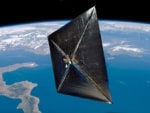NASA has established a competition encouraging amateur astronomers and veteran sky watchers to try and snap a photograph of its NanoSail-D solar satellite as it re-enters the Earth’s atmosphere during the next seven-to-fourteen days. Due to the unexpected stellar performance of the NanoSail-D’s solar canopy, claiming the $500 first-prize might take a while.
The satellite was deployed and successfully unfurled its 10-square-metre solar sail on January 20 this year. After orbiting the upper atmosphere for 95 days, the NanoSail-D will begin its descent from an altitude of 640 kilometres above the Earth, providing NASA scientists with important data solar sail technology’s potential to aid in returning de-commissioned satellites and space junk safely to Earth.
But soon after deployment, NASA’s team found the satellite’s polymer solar sail was facing in a direction of flight which caused it to orbit the Earth in a flat spin as opposed to a random tumble. This meant the sail encountered less drag, allowing the NanoSail-D to remain in orbit much longer than expected.
“Prior to launch, our original de-orbit analysis was based on a maximum drag attitude, which meant NanoSail-D would de-orbit in 70-120 days,” said Dean Alhorn, principal investigator for the NanoSail-D mission. “Based upon NASA’s current analytical assessments of the NanoSail-D tracking data, the team predicts NanoSail-D will continue to descend and eventually re-enter Earth’s atmosphere and disintegrate six months to one year from sail deployment.”
NASA says the NanoSail-D mission was an important test case for demonstrating the value of compact solar sail boom technology and alternative solar sail propulsion.
Humanity hasn’t been confined to littering the planet and space junk is becoming an increasing concern. A 1999 study mentioned on Space.com estimated there are around 4 million pounds of space junk in low-Earth orbit and some of this debris is moving at over 25,000 kilometers per hour. At those velocities, even small objects can pose a serious threat to hardware and astronauts.














































